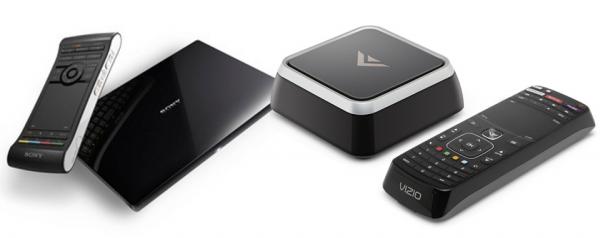Google TV Shootout: Sony NSZ-GS7 Versus Vizio Co-Star

There's no use pretending that Google TV wasn't a dud when the first products shipped back in late 2010. In fact, sales of Logitech's $300 Revue player were was so bad the company ran screaming from the settop-box market entirely, never to return. But now, like the Backstreet Boys and collateralized mortgages, Google TV is getting another shot, fueled by some much-needed upgrades to the software, including a more streamlined interface, improved search capabilities, and the ability (finally) to access the Android market, now called Google Play.
To see if so-called Google TV 2.0 is worthy of another try, we decided to put one of the newest devices - Sony's NSZ-GS7 streaming media player - to the test. But just as we were about to finalize testing, we also got our hands on Vizio's new Co-Star, which we added to the mix. Other newer Google TV devices include LG's G2-series LCD TVs, and a streaming media player from Hisense, with more on the way - but we'll get to those later.
Perhaps because of their common Google TV heritage, the Sony and Vizio players are more alike than they are different, although each imparts their own spin on the platform. Perhaps the biggest difference between the two, apart from their physical appearance, is their price - $99 for the Co-Star, and $199 for the NSZ-GS7. (Sony is helping to mitigate that disparity a bit via a promo that lets you add three new feature movies to your Google TV library.)
Unlike most streaming players we've tested, such as those from Roku or Apple TV, Google TV-powered devices are designed to sit between your cable or satellite box and your TV. (The other boxes connect directly to TV's secondary HDMI input.) One benefit is that you no longer have to switch inputs when choosing between live TV and the services and apps provided by the boxes, since they connect via the same HDMI input on your TV. But more importantly, live TV is now integrated within the Google TV application, so whatever's currently playing on live TV shows up as an option when you search for programs or movies. When the boxes are shut off, TV signals simply passes through the boxes as if they weren't there - at least in theory.
Hot Duo - literally
For this evaluation, both the NSZ-GS7 and the Co-Star were connected between a DirecTV HD DVR and a Sony 7.1-channel receiver, which fed video signals to a 55-inch 1080p Samsung LCD TV. Despite their common underpinnings, the Sony and Vizio boxes have radically different looks. The NSZ-GS7 is a wider, sleek-looking box that's roughly the size and shape as a Google Nexus 7 tablet, though it's about three times as thick. Like the Co-Star it's devoid of any buttons, so you'll need the remote control for all operations. Unlike the Co-Star, the Sony player has a small light on the front that illuminates when the box is turned on.
As you'd imagine, all connections - an HDMI input, HDMI output, two USB slots, an Ethernet jack, an IR blaster mini-jack that accepts the included IR blaster for controlling other gear, and the power cord receptacle - are located on the rear panel. The Sony also has an optical digital audio output - something absent from the Co-Star - that's useful for sending audio to an older receiver without HDMI inputs.
The Co-Star, by comparison, has more in common with the hockey-puck-shaped boxes from competitors such as Roku. Roughly four inches by four inches and just over an inch-and-half tall, the Co-Star is attractively styled, with silver accents against the box's black exterior. Although it's only slightly bigger than the Roku XD I already have in my system, it feels much more substantial, and it doesn't get pulled backwards by the heavyweight HDMI cables I use like the Roku does. The rear panel includes an HDMI input, HDMI output, a single USB port, an Ethernet jack, and the power-cord input. Unlike the Sony, which has an internal power supply, there's a wall wart at the plug end of the Co-Star power cord, but it shouldn't take up more than a single outlet in your power strip or wall outlet. As mentioned, the Co-Star lacks an optical or digital audio output, so your receiver will need to have HDMI inputs, and there's no power indicator light on the front of the box to let you know when the unit is on. The system's IR blaster is built into the remote control.
Thanks to the screwdriver-happy guys over at iFiXit, we know the Co-Star, like the Sony, is powered by a 1.2GHz dual-core Marvell processor. Both boxes run Android 3.2 (Honeycomb), though it's possible that Google TV could migrate to a newer version, such as Android 4.0 (Ice Cream Sandwich), at some point in the future.
Like most streaming boxes, both units can output 1080p video, though the quality of the video you'll get depends on the speed of your network connection. (Almost all the streaming movie services we've tested will dynamically adjust video quality based on what you're network can handle to avoid freezes and pixelation.) I didn't notice any difference in picture quality with the boxes. Both have built-in Wi-Fi and Bluetooth, and they both support a pretty wide range of file formats and audio and video codecs, including Adobe Flash and HTML 5. Both boxes also support 3D, so they can pass 3D signals from a Blu-ray player or cable/satellite settop box to a 3D TV.
One word of caution: Neither box has an internal fan, so they can get quite hot, especially the Sony. My advice is to keep both well ventilated, and avoid placing either on top of any other heat-sensitive gear if possible.






























































